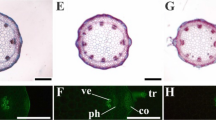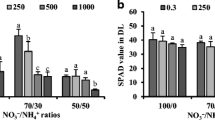Abstract
Two Elsholtzia haichowensis S. populations, copper-tolerant (TLS) and non-tolerant (HA) ones were studied in hydroponic experiment for the nitrogen assimilation and plant growth under excess Cu conditions. The results demonstrated that there were surely the differences in nitrogen assimilation and plant growth between the two populations. Excess Cu caused evident decreases in the shoot and root biomass and root/shoot biomass ratio in HA population while no significant changes happened in TLS population. In addition, in HA population, excess Cu also induced apparent declines in activities of nitrate reductase (NR, EC 1.6.6.1) and glutamine synthetase (GS, EC 6.3.1.2) in the leaves and roots as well as the contents of nitrate, ammonium and amino acids in the roots. In TLS population, excess Cu did not significantly affect the NR activities in the leaves and roots and the nitrate content in the roots, and apparently elevated the root ammonium and amino acids contents, although it also clearly reduced the GS activities in the leaves and roots. Besides, with the addition of Cu in the culture solution, the Cu contents in the leaves and roots of the two populations markedly increased. But this increase was significantly lower in TLS population than that in HA population; the fact might be partly responsible for the relative stabilization of nitrogen assimilation in TLS population compared to that in HA population.







Similar content being viewed by others
References
Ali, N. A., Bernal, M. P., & Ater, M. (2002). Tolerance and bioaccumulation of copper in Phragmites australis and Zea mays. Plant and Soil, 239, 103–111.
Baker, A. J. M. (1981). Accumulators and excluders strategies in the response of plants to heavy metals. Journal of Plant Nutrition, 3, 643–654.
Bradford, M. M. (1976). A rapid and sensitive method for the quantitation of microgram quantities of protein utilizing the principle of protein-dye binding. Analytical Biochemistry, 72, 248–254.
Brun, L. A., Corff, J. L., & Maillet, J. (2003). Effects of elevated soil copper on phenology, growth and reproduction of five ruderal plant species. Environmental Pollution, 122, 361–368.
Campbell, W. H. (1999). Nitrate reductase structure, function and regulation: Bridging the gap between biochemistry and physiology. Annual Review of Plant Physiology and Plant Molecular Biology, 50, 277–303.
Cataldo, D. A., Haroon, M., Schrader, L. E., & Youngs, V. L. (1975). Rapid colorimetrie determination of nitrate in plant tissue by nitration of salicylic acid. Communications in Soil Science and Plant Analysis, 6, 71–80.
Chen, L. M., & Kao, C. H. (1998). Relationship between ammonium accumulation and senescence of detached rice leaves caused by excess copper. Plant and Soil, 200, 169–173.
Crawford, N. M., & Glass, A. D. M. (1998). Molecular and physiological aspects of nitrate uptake in plants. Trends in Plant Science, 3, 389–395.
Dahmani-Muller, H., Oort, F. V., Gelie, B., & Balabane, M. (2000). Strategies of heavy metal uptake by three plant species growing near a metal smelter. Environmental Pollution, 109, 231–238.
Demirevska-Kepova, K., Simova-Stoilova, L., Stoyanova, Z., Holzer, R., & Feller, U. (2004). Biochemical changes in barley plants after excessive supply of copper and manganese. Environmental and Experimental Botany, 52, 253–266.
De Vos, C. H. R., Schath, H., De Waal, M. A. M., Vooijs, R., & Ernst, W. H. O. (1991). Increased resistance to copper-induced damage of the root cell plasmalemma in copper tolerant Silene cucubalus. Physiologia Plantarum, 82, 523–528.
De Vos, C. H. R., Ten Bookum, W. M., Vooijs, R., Schat, H., & De Kok, L. J. (1993). Effect of copper on fatty acid composition and peroxidation of lipids in roots of copper tolerant and sensitive Silene cucubalus. Plant Physiology and Biochemistry, 31, 151–158.
Ernst, W. H. O. (2005). Phytoextraction of mine wastes – Options and impossibilities. Chemie Der Erde-Geochemistry, 65(Suppl 1), 29–42.
Ernst, W. H. O., Nelissen, H. J. M., & Ten Bookum, W. M. (2000). Combination toxicology of metal-enriched soils: Physiological responses of a Zn- and Cu-resistant population of Silene vulgaris on polymetallic soils. Environmental and Experimental Botany, 43, 55–71.
Fernandes, J. C., & Henriques, F. S. (1991). Biochemical, physiological, and structural effects of excess copper in plants. Botanical Review, 57, 246–273.
Hall, J. L. (2002). Cellular mechanisms for heavy metal detoxification and tolerance. Journal of Experimental Botany, 53, 1–11.
Hecht, U., & Mohr, H. (1990). Factors controlling nitrate and ammonium accumulation in mustard (Sinapis alba) seedlings. Physiologia Plantarum, 78, 379–387.
Hsieh, I., & Hsu, H. (1954). On Elsholtzia haichowensis: An indicator plant for copper. Bulletin of the Geological Society of China, 32(4), 360–367. (in Chinese)
Hsu, Y. T., & Kao, C. H. (2003). Accumulation of ammonium ion in cadmium tolerant and sensitive cultivars of Oryza sativa. Plant Growth Regulation, 39, 271–276.
Hua, J., & Lu, B. (1996). Early mining of copper material deposits in the middle and lower reaches of Yangtze River and China’s bronze civilization. Study of History and Natural Sciences, 15, 1–16. (In Chinese)
Ishida, H., Anzawa, D., Kokubun, N., Makino, A., & Mae, T. (2002). Direct evidence for non-enzymatic fragmentation of chloroplastic glutamine synthetase by a reactive oxygen species. Plant, Cell, & Environment, 25, 625–631.
Kabata-Pendias, A., & Pendias, H. (1992). Trace elements in soils and plants (2nd ed.). Boca Raton, FL: CRC.
Ke, W. S., **ong, Z. T., Chen, S. J., & Chen, J. J. (2007a). Effects of copper and mineral nutrition on growth, copper accumulation and mineral element uptake in two Rumex Japonicus populations from a copper mine and an uncontaminated field sites. Environmental and Experimental Botany, 59, 59–67.
Ke, W. S., **ong, Z. T., **e, M. J., & Luo, Q. (2007b). Accumulation, subcellular localization and ecophysiological responses to copper stress in two Daucus carota L. populations. Plant and Soil, 292, 291–304.
Klobus, G., Burzynski, M., & Buczek, J. (2002). Heavy metals and nitrogen metabolism. In M. N. V. Prasad & K. Strzalka (Ed.), Physiology and biochemistry of metal toxicity and tolerance in plants (pp. 325–355). London: Kluwer.
Liu, J., & **ong, Z. T. (2005). Differences in accumulation and physiological response to copper stress in three populations of Elsholtzia haichowensis S. Water, Air and Soil Pollution, 168, 5–16.
Liu, J., **ong, Z. T., Li, T. Y., & Huang, H. (2004). Bioaccumulation and ecophysiological responses to copper stress in two cotypes of Rumex dentatus L. from Cu contaminated and non-contaminated sites. Environmental and Experimental Botany, 52, 43–51.
Llorens, N., Arola, L., Blade, C., & Mas, A. (2000). Effects of copper exposure upon nitrogen metabolism in tissue cultured Vitis vinifera. Plant Science, 160, 159–163.
Lolkema, P. C., Donker, M. H., Schouten, A. J., & Ernst, W. H. O. (1984). The possible role of metallothioneins in copper tolerance of Silene cucubalus. Planta, 162, 174–179.
Luna, C. M., Casano, L. M., & Trippi, V. S. (1997). Nitrate reductase is inhibited in leaves of Triticum aestivum treated with high levels of copper. Physiologia Plantarum, 101, 103–108.
Macnair, M. R. (1993). The genetics of metal tolerance in vascular plants. New Phytologist, 124, 541–559.
Mathys, W. (1975). Enzymes of heavy-metal-resistant and non-resistant populations of Silene cucubalus and their interaction with some heavy metals in Vitro and in Vivo. Physiologia Plantarum, 33(2), 161–165.
Mazen, A. M. A. (2004). Accumulation of four metals in tissues of Corchorus olitorius and possible mechanisms of their tolerance. Biologia Plantarum, 48, 267–272.
Miflin, B. J., & Lea, P. J. (1976). The pathway of nitrogen assimilation in pants. Phytochemistry, 15, 873–885.
Miflin, B. J., & Lea, P. J. (1982). Ammonium assimilation and amino acid metabolism. In D. Boulter & B. Parthier (Eds.), Nucleic acid and proteins in plants I. Encyclopedia of plant physiology. New series (pp. 5–64). Berlin: Springer.
Monni, S., Salemaa, M., & Millar, N. (2000). The tolerance of Empetrum nigrum to copper and nickel. Environmental Pollution, 109, 221–229.
Murphy, A., & Taiz, L. (1997). Correlation between potassium efflux and copper sensitivity in 10 Arabidopsis Ecotypes. New Phytologist, 136, 211–216.
Ouzounidou, G., Ciamporova, M., Moustakas, M., & Karataglis, S. (1995). Responses of Maize (Zea mays L.) plants to copper stress. I Growth, mineral content and ultrastructure of roots. Environmental and Experimental Botany, 35, 167–176.
Reilly, C. (1972). Amino acids and amino acid-copper complexes in water-soluble extracts of copper-tolerant and non-tolerant Becium homblei. Zeitschrift fuÉr Pflanzenphysiologie, 66, 294–296.
Scheible, W. R., Morcuende, R., Czechowski, T., Fritz, C., Osuna, D., Palacios-Rojas, N., et al. (2004). Genome-wide reprogramming of primary and secondary metabolism, protein synthesis, cellular growth processes, and the regulatory infrastructure of Arabidopsis in response to nitrogen. Plant Physiology, 136, 2483–2499.
Silveira, J. A. G., Matos, J. C. S., Cecatto, V. M., Viegas, R. A., & Oliveira, J. T. A. (2001). Nitrate reductase activity, distribution, and response to nitrate in two contrasting Phaseolus species inoculated with Rhizobium spp. Environmental and Experimental Botany, 46, 37–46.
Solomonson, L. P., & Barber, M. J. (1990). Assimilatory nitrate reductase: Functional properties and regulation. Annual Review of Plant Physiology and Plant Molecular Biology, 41, 225–253.
Stadtman, E. R., & Oliver, C. N. (1991). Metal-catalyzed oxidation of proteins. Journal of Biological Chemistry, 266, 2005–2008.
Stitt, M., & Krapp, A. (1999). The molecular physiological basis for the interaction between elevated carbon dioxide and nutrients. Plant, Cell & Environment, 22, 583–622.
Stitt, M., Müller, C., Matt, P., Gibon, Y., Carillo, P., Morcuende, R., et al. (2002). Steps towards an integrated view of nitrogen metabolism. Journal of Experimental Botany, 53, 959–970.
Wang, M. J. (1997). Land application of sewage sludge in China. Science of the Total Environment, 197, 149–160.
Woolhouse, H. W. (1983). Toxicity and tolerance in the responses of plants to metals. In O. L. Lange, P. S. Nobel, C. B. Osmond, & H. Ziegler (Eds.), Encyclopedia of plant physiology (vol. 12C, pp. 245–300). Berlin: Springer.
**ong, Z. T., Liu, C., & Geng, B. (2006). Phytotoxic effects of copper on nitrogen metabolism and plant growth in Brassica pekinensis Rupr. Ecotoxicology and Environmental Safety, 64, 273–280.
Zhang, C. F., Peng, S. B., Peng, X. X., Chavez, A. Q., & Bennett, J. (1997). Response of glutamine synthetase isoforms to nitrogen sources in rice (Oryza sativa L.) roots. Plant Science, 125, 163–170.
Acknowledgement
This work was funded by the National Natural Science Foundation of China (Project 20477032).
Author information
Authors and Affiliations
Corresponding author
Rights and permissions
About this article
Cite this article
Li, M., **ong, Z., Dai, L. et al. Effects of Copper on Nitrogen Assimilation in Copper-tolerant and Non-tolerant Populations of Elsholtzia haichowensis S.. Water Air Soil Pollut 184, 323–333 (2007). https://doi.org/10.1007/s11270-007-9419-8
Received:
Accepted:
Published:
Issue Date:
DOI: https://doi.org/10.1007/s11270-007-9419-8




